Scout-Arrival Study
Summary of 2024 reports
3286 Adult Scout Reports submitted.
108 Subadult Male Reports submitted.
ENTERING AND VIEWING RESULTS IN THE SCOUT-ARRIVAL STUDY CONTINUES TO BE A FREE SERVICE PROVIDED BY THE PMCA.
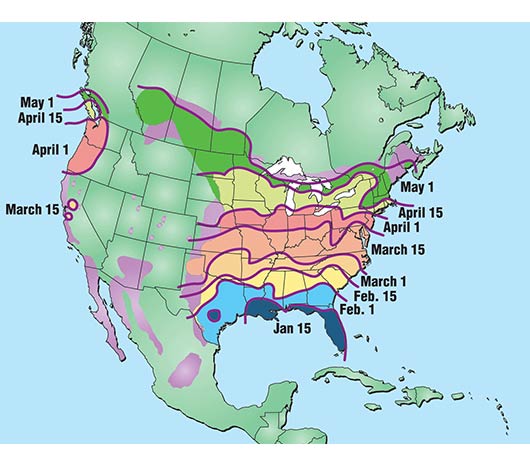
Purple Martin “Scout”: The term scout is given to the very first martin(s) observed back at an active colony site each year. Scouts are the oldest individuals in the population, who migrate north as early as weather allows. They can be either male or female. People once thought that martin scouts flew North in search of suitable breeding sites and then returned South to guide their colonies back to the sites they had selected. This is not true. A martin “colony” is a random aggregation of unrelated birds attracted to a common breeding site. Colony members do not travel in or function as a flock. They arrive in Spring, and depart in late Summer, independently of each other. Martin scouts will stay at a site if they nested there the previous year, or move on if they are migrants, resting on the way to their breeding sites.
Scout-Arrival Study: The Scout-Arrival Study documents the first arriving Purple Martins at nesting sites. Landlords throughout the breeding range submit their first returning adult and sub-adult to the PMCA. This information is used to track the spring migration progress of Purple Martins.
This information is important to landlords who close their martin housing during early spring to keep out competing bird species. Landlords use Scout-Arrival Data to determine the best time to open their housing for martins in their area. Everyone is encouraged to participate in this ongoing study by sending your scout arrival dates to the PMCA. We will add your dates to our database, and will map the data on our website so that others can track the martins' movements. By adding to our knowledge, participants can help ensure the long-term survival of the birds they love.
How to Participate: Submit your scout dates for free using the report form on our website or phone, e-mail, fax, or mail us your scout date for this year. If you have written records for other years and have never sent them in to us in the past, please do so at any time. If you do not have an account with the PMCA you will need to create one. This will allow you to better manage your data. Creating an account is free and requires no membership dues.
Purple Martin ID: During the breeding season there are four distinct age/sex classes for Purple Martins. These are adult male, adult female, subadult male, and subadult female. After nestlings fledge, there is a fifth distinguishable age class of juvenile. Juveniles cannot be sexed by plumage.
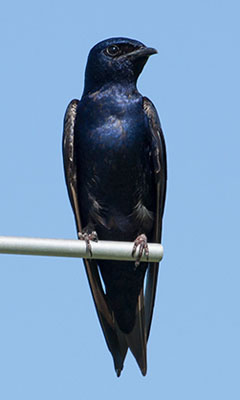
Adult (ASY) Male—Adult males are the only Purple Martins to have iridescent, purple feathers covering the entire body. They do not get their full plumage until the 3rd calendar year.
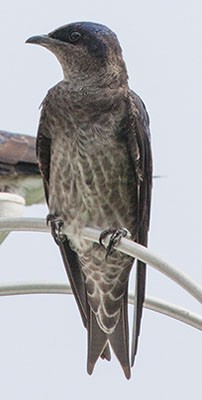
Adult (ASY) Female: Adult females have more purple on their head and back than subadult females. Their undertail feathers are much darker than subadults—all brown/grey feathers with a white rim on the outer edge. They will not have any purplish feathers on their chest, belly, or undertail.
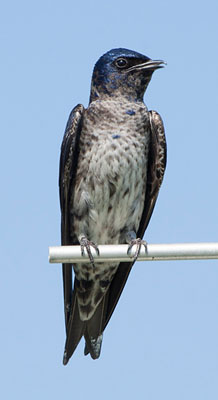
Subadult (SY) Male: Often the hardest to identify, will have at least one, but usually many solid-purple feathers either on their chins, throats, bellies, or undertails.
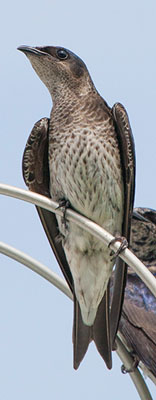
Subadult (SY) Female: Subadult females have a much lighter purple to brownish color on their back feathers. The undertails are all white or light-colored feathers with brown pinstripes down the center.
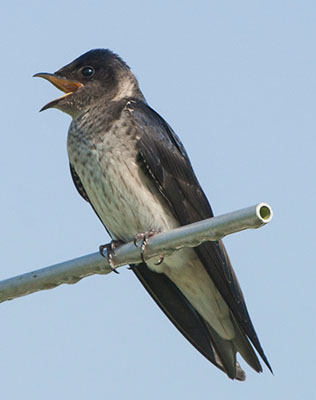
Hatching Year (HY): The sex of a hatching year or juvenile bird cannot be determined by sight. Hatching year Purple Martins will have a stubby tail—shorter than the wing feathers. They are a dull brownish-grey color and still have yellow inside their beak.
